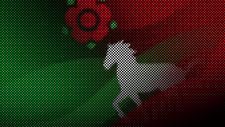
Our state - 75 years of North Rhine-Westphalia
We wish you a warm welcome to our exhibition here in the Behrensbau – “we” being the newly-established foundation of the House of the History of North Rhine-Westphalia. A few years from now, a completely new museum will open on these premises. For now, this exhibition is a first step towards that goal, allowing us to take a look together at several of the most moving moments of the past 75 years.
We have selected 39 stations for our tour. Follow the marked path on the floor, or else simply follow the numbers and photos on your smartphone. Either option will lead you to the next exhibit and station.
At the very heart of Europe, North Rhine-Westphalia was created after the Second World War out of territory on the rivers Rhine and Ruhr, Weser, Ems and Lippe. To the right of the entrance you can see its coat of arms: steed, Rhine and rose. They represent the three regions of the state: Westphalia, the Rhineland and Lippe. Today, North Rhine-Westphalia is home to 18 million people, the most populous of Germany’s 16 states.
“Our state” has experienced much in 75 years. What were its biggest challenges? And how were they overcome?
Characterised at first by hardship and new beginnings, the subsequent history of North Rhine-Westphalia was eventful: Founded by the British occupying forces, a new democracy emerged. Time and again, people found refuge here over the decades. Coal shaped the state above and below ground. The environment was threatened in multiple ways, as was the security of those who lived here. Education and justice were the concerns of generations. Religions and society shaped their coexistence. Culture and media continually reinvented themselves.
A look into the past shows that many of yesterday’s issues have lost none of their relevance today.